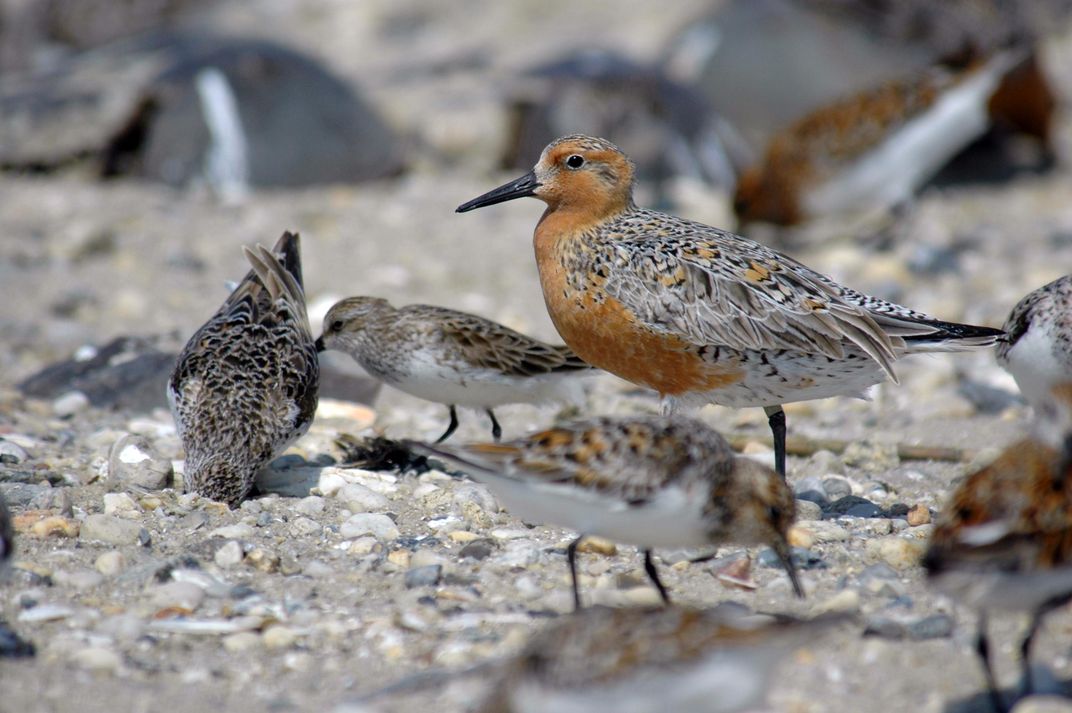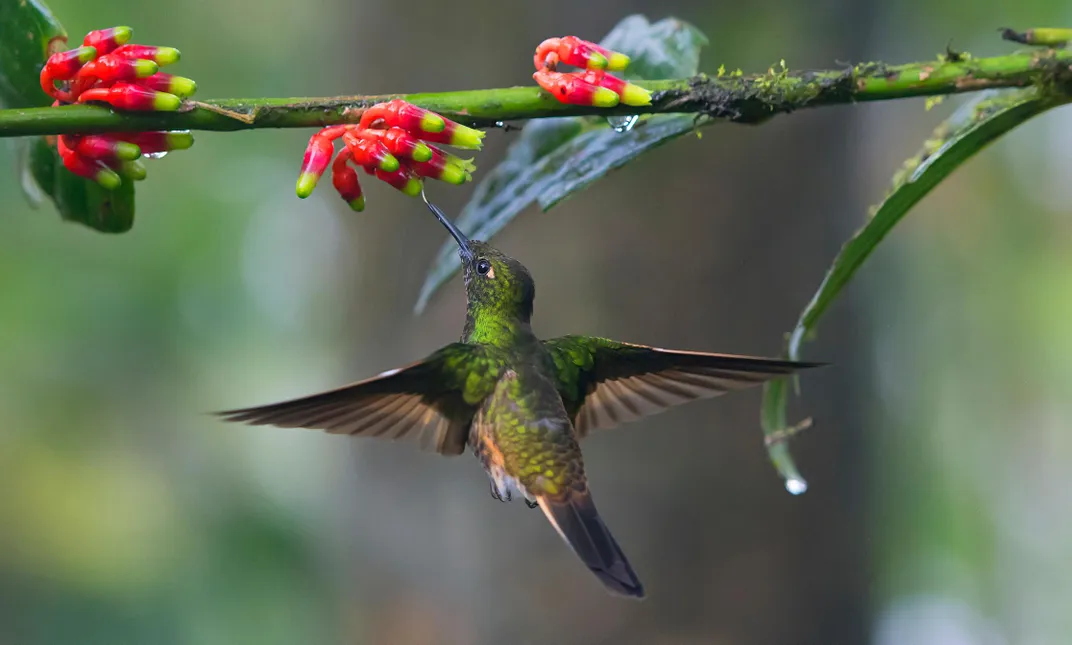North America Has Lost Nearly 3 Billion Birds Since 1970
The staggering population loss of 29 percent of North American birds could signal an ecological crisis
/https://tf-cmsv2-smithsonianmag-media.s3.amazonaws.com/filer/46/c7/46c7da28-e266-497b-9bc3-d25e291ee962/istock-1144653112.jpg)
It’s hard to imagine a place in the world where you can’t find a bird—a place where you can’t look to the sky and see one flying overhead, or see one hop across the sidewalk, or close your eyes and hear at least one singing its song.
Take the Red Knot, a shoreline bird that migrates to the Delaware Bay in summer to indulge on horseshoe crab eggs until it’s fat enough to fly all the way to the Arctic Circle to breed. Or consider the Baltimore Oriole, a songbird that breeds in summer from Louisiana up along the U.S. East Coast and into Central Canada, then spends its winters in the Caribbean, across Central America and down to the northern regions of South America.
Birds thrive in grasslands, deserts, mountains, forests, tundra and along the oceans’ coasts. But the skies have grown more silent in recent decades. Since 1970, North America has lost more than 2.9 billion birds, according to a study published today in the journal Science. In less than half a century, the avian population of the continent has declined by some 29 percent, or more than one in four birds.
For the first time, researchers found that threatened species aren’t the only birds suffering population loss. In fact, common birds—including beloved backyard companions like sparrows and blackbirds—are taking the biggest hit.

“You can be anywhere in the world, at any time of day and see a bird,” says Jordan Rutter, a spokesperson for American Bird Conservancy. “We’re not talking about penguins here. Birds like the common grackle are birds we can directly resonate with because they’re birds that we always see. They’re not in far distant places. They’re in our backyard.”
The new study used nearly 50 years of monitoring data collected largely by bird watchers and citizen scientists. These efforts include the North American Breeding Bird Survey coordinated by the United States Geological Survey and the Canadian Wildlife Service, Audubon’s Christmas Bird Count, and the International Shorebird Survey. The team then cross-referenced bird count data with radar data from 143 weather satellites that have been used to track migrating birds at night for the last decade.
The results of their analysis of 529 avian species reveal some stark realities. “A total of 419 native migratory species experienced a net loss of 2.5 billion individuals,” the study says. More than 90 percent of the total loss can be attributed to just 12 bird families, including sparrows, warblers, blackbirds, larks and finches. Some of these widespread birds are so-called “habitat generalists,” or birds that can thrive just about anywhere. The large-scale loss of these hardy birds reveals the extent to which avian animals across the world are struggling to survive.
“We’re losing common species. We’re not keeping common species common. We’re failing at that,” says study co-author Pete Marra, former director of the Smithsonian Migratory Bird Center and current director of the Georgetown Environment Initiative at Georgetown University.

Grassland birds, such as meadowlarks and grasshopper sparrows, took the biggest hit. They’ve lost 700 million individuals across 31 species, equivalent to a 53 percent population loss since 1970. Forest-dwelling birds, which are more abundant, lost one billion individuals. Shorebirds, which traverse across full hemispheres during migration, are “experiencing consistent, steep populations loss” at a rate of 37 percent in less than 50 years.
Even invasive or introduced species are faring poorly, suggesting declining species aren’t being replaced by species that do well in human-altered landscapes.
“This is a big, big punch in our continental gut in terms of what we’re doing to our environment,” Marra says.
Scientifically speaking, birds are considered indicator species, or animals used to infer the health of an entire ecosystem. They are worldwide “canaries in the coal mine,” which refers to the 20th-century practice of carrying caged birds into mines to detect toxic gases before humans suffer harmful effects.
Famed 20th century ornithologist Roger Tory Peterson called birds “an ecological litmus paper.” They are crucial to the health of many ecosystems, and their populations anticipate the health of whole environments.
/https://tf-cmsv2-smithsonianmag-media.s3.amazonaws.com/filer/67/b9/67b943df-b620-4e40-8eaa-393b747745f1/screen_shot_2019-09-19_at_101318_am.png)
Birds are “amazingly efficient” dispersers of seeds, explains Scott Sillett, current director of Smithsonian’s Migratory Bird Center who was not an author of this study. Take jays, for instance, which not only harvest acorns but replant them as well, successfully maintaining oak forests. Hummingbirds are important pollinators across North America, and birds keep insect populations in check. Black-billed cuckoos happily devour defoliating caterpillars that can destroy forests, for example. And predatory birds, like falcons, devour rodents that often spread human diseases. Even the smallest bird helps control the spread of plants or insects.
“Birds are at the top of the food web,” Sillett says. “Birds are the sentinel. If you have huge declines of birds, it tells you something is amiss.”
Other organisms on Earth are experiencing similar losses. We’re facing an “insect apocalypse,” and amphibians are declining at an “alarming and rapid rate.”
We have lost avian species before. Consider the passenger pigeon. The species numbered in the hundreds of millions in the 1870s, by at least one naturalist’s count. Others have estimated the pigeons once boasted closer to 3 to 5 billion individuals. They were stable, even dominant, for 20,000 years. But their large population left them vulnerable to threats, such as human hunting and habitat loss, and the easy breeding they enjoyed for thousands of years left them poorly equipped for adaptation. By the 1890s, there were only dozens. And by 1914, the last captive passenger pigeon, Martha, died.
“It’s the passenger pigeon story. Those were the most numerous. It went from billions of birds to nothing. It can happen again,” says Sara Hallager, the Smithsonian National Zoo’s curator of birds, who was not involved in this study.
Not all species are in decline, however. Wetland birds were the “the only biome to show an overall net gain in numbers,” up 13 percent, according to the study. And waterfowl—a subset of wetland birds—are thriving, up an astounding 56 percent from 1970s numbers.
Conservation efforts are largely to thank for the success of waterfowls, experts say. Consider the wood duck. “Being shot at all seasons of the year, [wood ducks] are becoming very scarce and are likely to be exterminated before long,” renowned naturalist Joseph Grinnell wrote in 1901, according to Cornell University’s All About Birds blog.
But thanks in large part to efforts by hunters, federal lawmakers introduced the “Duck Stamp Act” in 1934, mandating hunting licenses and seasons, and putting 98 cents of every dollar sold on so-called “duck hunting stamps” toward the Migratory Bird Conservation Fund. That money is used to “purchase or lease wetlands and wildlife habitat for inclusion in the National Wildlife Refuge System,” according to the U.S. Fish and Wildlife Service.
Since 1934, the fund has accumulated about $800 million dollars through duck stamps, and more than 5.7 million acres of habitat have been protected. Today, wood ducks have a population of about 300,000 and are not considered endangered or threatened, according to the National Wildlife Federation.
“The rebounding of the waterfowl population is a good object lesson in protecting wildlife,” says Sillet. “Waterfowl conservation has a dedicated funded stream. It’s a reminder that those of us who like to hike, who like to watch birds, who like to paint birds—we have to come up with innovative ways to contribute financially and make a difference.”
Raptors, including eagles and hawks, have also found success since 1970, according to the new study. These predatory birds, along with waterfowl and other game birds like turkeys and grouse, gained some 250 million individuals since 1970. Raptors in particular have recovered from grave losses sustained from the harmful pesticide DDT, which caused many raptors to lay eggs with abnormally thin shells that would crack under the weight of incubating chicks. The USDA started regulating the chemical in the late 1960s, and ultimately banned it in 1972, after public concern grew following naturalist Rachel Carson’s landmark serialized New Yorker essay and later book, Silent Spring.
Raptor recovery was successful, Marra explains, because researchers knew exactly which species were dying and why. The new study, however, identifies the losses without knowing all the causes. Scientists do know what birds are up against, however, with habitat loss identified as the biggest damager. Climate change, disrupted migration patterns and pesticide use are also major factors. All in all, birds are likely being hit with a several threats at once.
“There are enormous things happening now that are converging,” Marra says.
For researchers, the next step is pursing long term, species-level investigations in specific geographic locations. Advances in tracking methods, especially the ability to tag smaller birds, is driving the research forward. Right now, there isn’t an easy way to figure where birds are dying or at what stage in their lives, says Christy Morrissey, a professor of biology at the University of Saskatchewan who was not involved in the study.
“This paper doesn’t dig into the ‘why.’ It’s just the ‘what’ at this stage,” Morrissey says. “But there are lots of clues here. It’s a detective story. Which environment did we lose the most birds? Which geographic location?”
Jordan Rutter of the American Bird Conservancy points out that lawns account for more than 40 million acres of land in the United States, making grass the biggest crop in the country. Converting some of that to natural spaces, by growing native plants and planting trees in yards, can make an impact, she says. Individuals can also contribute to bird conservation by reducing kills at windows, reducing the use of pesticides in gardens, and keeping cats indoors, Marra says.
Industrial agriculture may present an even bigger challenge. Morrissey notes that the species disappearing most rapidly—sparrows, blackbirds, larks—are associated with agriculture. In recent decades, agriculture has shifted to an industrial model.
“We’ve increased food potential, but we’ve created sterile landscapes,” Morrissey says. “We need to change the way we grow food. Birds are signaling that we are doing it wrong.”
Revamping farming practices may seem like a massive undertaking, but Morrissey points to the 1990s effort to switch to no-till farming, which reduces greenhouse gases and soil erosion, as an example of relatively rapid implementation of change in U.S. agriculture. “It’s quite doable. Farmers are innovators. And they’ve done it before. There’s this great opportunity to have a huge impact on birds and other biodiversity.”
In Silent Spring, Rachel Carson imagines a desolate future without birds. “It was a spring without voices. On the mornings that had once throbbed with the dawn chorus of robins, catbirds, doves, jays, wrens, and scores of other bird voices there was now no sound; only silence lay over the fields and woods and marsh.”
To prevent such a future, humans may once again need to rally their efforts to identify and prevent a crisis of wildlife.
/https://tf-cmsv2-smithsonianmag-media.s3.amazonaws.com/accounts/headshot/rachael.png)




/https://tf-cmsv2-smithsonianmag-media.s3.amazonaws.com/accounts/headshot/rachael.png)